Occupational environment monitoring at the factory producing rice
99,000 ₫
Note: The above price is calculated for one sample, the price may fluctuate depending on the area of the environment to be monitored and the movement of the market. For more accurate price support, please refer to the quotation table or contact directly with our consulting staff.
Environmental monitoring of rice manufacturing factories is a session of collecting, analyzing, and evaluating factors in the workplace that may be harmful to the health of workers.
Table of Contents
Toggle1. Overview of Rice Production Factories
a. What is a rice production factory?
Rice production factories are facilities specializing in processing and packaging rice from raw rice materials. These factories typically receive rice from farms or other agricultural areas and then carry out processing stages to produce high-quality rice products.

b. Production stages in rice production factories
Production stages in rice production factories generally include:
- Cleaning and weed removal: Incoming rice is cleaned by removing impurities, weeds, or other unwanted grains.
- Hulling: This process removes the outer husk of the rice grain to obtain white rice inside. This is typically done using hulling machines, either automatically or manually.
- Drying: After hulling, rice is dried to remove moisture and maintain freshness.
- Sorting and grading: Dried rice is sorted and graded based on quality, size, and color, usually with the help of machinery and sorting tools.
- Packaging: Rice that has been sorted and graded is packaged into suitable containers for storage and transportation.
- Quality control: Throughout production, rice is checked to ensure compliance with standards and desired quality.

c. Machinery used in rice production factories
Rice production factories use a variety of machines for different stages of production. Common machines include:
- Cleaning and weed separation machines: These remove impurities, weeds, and unwanted grains from rice.
- Basic rice machines: Used to remove the husk from rice grains, often involving moisture treatment, processing, and husk separation through friction or pressure.
- Rice forming machines: Used to form rice grains from de-husked paddy, including forming and drying stages to remove moisture.
- Rice drying machines: Used to dry rice after hulling and forming.
- Packaging machines: Used to pack rice into bags or retail units like boxes or pouches.
- Rice milling machines: Used to grind rice into rice flour for products such as cakes, noodles, or porridge.

d. Occupational diseases rice factory workers may face
Workers in rice production factories may be exposed to environmental and occupational hazards causing occupational diseases. Common risks include:
- Lung diseases: Exposure to rice dust or grain dust during hulling, forming, or milling can cause respiratory issues, including pneumonia or pneumoconiosis.
- Skin diseases: Prolonged contact with water or chemicals during rice processing may cause dermatitis or other skin problems.
- Spinal and joint issues: Manual labor such as lifting, transporting, or packaging rice may lead to musculoskeletal strain and injury.
- Hand-foot-mouth disease: Contact with contaminated water or environments may expose workers to infectious agents causing sores in the mouth, hands, and feet.
- Occupational accidents: Workers may face accidents including slips, cuts, collisions, or injuries from machinery and equipment.

e. Popular types of rice on the market
Popular rice varieties include:
- White rice: Common long-grain rice with mild flavor, widely used in Asian and international cuisines.
- Fragrant rice (sticky rice): Short-grain rice with a creamy white color and a distinctive, strong aroma. Used in sticky rice dishes, desserts, and special delicacies.
- Glutinous rice: Short, round grains used for sticky rice dishes, rice cakes, and other chewy foods.
- Black rice: Naturally black with high antioxidant content, rich in nutrients and flavor, often used in creative culinary dishes.
- Brown rice: Unpolished rice retaining the bran layer, higher in fiber and nutrients than white rice.
- Red rice: Red or reddish-brown rice containing anthocyanins, used in desserts and salads.
Other varieties include organic rice, green sticky rice, and specialty regional types, chosen based on consumer preference.
2. Overview of Occupational Environment Monitoring Services
a. What is occupational environment monitoring in rice factories?
Occupational environment monitoring in rice production factories involves collecting, evaluating, and analyzing workplace environmental factors to take timely measures, reduce health hazards for workers, and prevent occupational diseases. Monitoring is a mandatory requirement for rice factories.
This monitoring plays a critical role in protecting workers’ health, as employees are the main resource generating profit for the company. Frequent exposure to hazardous factors exceeding permissible limits can adversely affect health and lead to occupational diseases.
REGISTER FOR OCCUPATIONAL ENVIRONMENT MONITORING SERVICE
b. An Toan Nam Viet’s occupational environment monitoring program
An Toan Nam Viet’s program is designed by monitoring engineers specializing in occupational safety and environmental protection. It uses modern measurement methods to monitor air quality, water, microclimate, physical conditions, and dust in the workplace. The program ensures a safe working environment and protects workers’ health.
It also plays a key role in researching and developing new solutions to improve workplace environmental quality. With the dedication and professionalism of the monitoring team, An Toan Nam Viet’s proprietary program is a breakthrough in occupational safety and environmental management in Vietnam.

c. Standardization in occupational environment measurement
Standardization ensures accurate and reliable measurement results. An Toan Nam Viet follows recognized standards and procedures from the Ho Chi Minh City Department of Health. Data collected is highly reliable for evaluating workplace conditions and improving the environment for worker health.
Standardized procedures are carried out by qualified monitoring experts, ensuring managers and specialists can trust results and make informed decisions.
By applying standardized procedures, An Toan Nam Viet demonstrates its commitment to a safe working environment while contributing to improved occupational safety management in Vietnam.
d. Reporting monitoring results at rice factories
Monitoring results are prepared according to Form No. 04, Appendix III of Decree 44/2016/ND-CP, in two copies: one sent to the contracted workplace, one retained by the monitoring organization.
Retention is legally indefinite.

e. Frequency of occupational environment monitoring as required by law
According to Clause 2 of Article 18 of the Law on Occupational Safety and Health 84/2015/QH13, employers must monitor workplace environments at least once per year.
f. Deadline for submitting monitoring reports as required by law
The deadline is before December 31 each year. Production enterprises must submit occupational environment monitoring reports to the local Department of Health where the head office and employees are located.
When there are changes in production processes or renovations that may introduce new hazards, enterprises must update occupational hygiene records regarding harmful factors that require monitoring.
g. Penalties for violations regarding occupational environment monitoring for employers
According to Article 27 of Decree No. 12/2022/ND-CP dated January 17, 2022:
- Clause 2: Fine of VND 2,000,000 – 5,000,000 for employers who fail to publicly disclose monitoring results to workers immediately.
- Clause 3: Fine of VND 20,000,000 – 40,000,000 for employers who fail to conduct monitoring to control hazards to workers’ health as required by law.
- Clause 4: Fine of VND 40,000,000 – 60,000,000 for employers who collude with monitoring organizations to falsify results but not to the level of criminal liability.
3. Harmful environmental factors for workers in rice processing factories
Workers in rice processing factories may encounter several harmful environmental factors that can affect their health. The following are some of the harmful environmental factors in rice processing factories:
- Rice dust: During rice production, handling, bran separation, and drying processes can generate rice dust. Inhaling airborne rice dust may cause respiratory irritation, pneumonia, and other health problems.
- Chemical fumes: The use of chemicals in rice production, such as pesticides, bleaching agents, and preservatives, can produce hazardous fumes. Inhaling these fumes can irritate the respiratory system, skin, and eyes, and may damage the nervous system and other internal organs.
- Noise: Machinery and equipment in rice processing factories often generate high noise levels. Continuous and excessive noise can cause long-term hearing damage, stress, sleep disturbances, and overall health issues.
- Temperature and humidity: Working environments in rice factories often have high temperature and humidity. Improper temperature and humidity conditions can make work difficult and cause fatigue and discomfort for workers.
- Physical hazards: Rice processing stages may require interaction with machinery and equipment, posing risks of collisions, cuts, punctures, and slips. Failure to follow safety procedures and use protective equipment can lead to injuries and workplace accidents.
REGISTER FOR OCCUPATIONAL ENVIRONMENT MONITORING SERVICE
4. Measures to improve working conditions in rice processing factories
To improve working conditions in rice processing factories and protect workers’ health, the following measures can be implemented:
- Rice dust management: Ensure effective dust extraction systems to reduce airborne rice dust. Use personal protective equipment such as masks to prevent inhalation of rice dust.
- Ensure ventilation and extraction systems: Improve ventilation and exhaust systems to ensure proper air circulation, removing chemical fumes and harmful substances from the workplace.
- Noise control: Install soundproofing measures and provide hearing protection to reduce noise to safe levels. Design and maintain machinery to minimize noise generation.
- Temperature and humidity control: Provide air conditioning and humidity control systems to create a comfortable and safe working environment.
- Training and use of protective equipment: Ensure workers are trained in occupational safety and correctly use protective equipment such as helmets, gloves, goggles, and safety shoes to prevent injuries and hazards.
- Compliance with safety procedures: Implement occupational safety procedures, ensuring workers understand and follow safety regulations and use machinery and equipment correctly.
- Periodic inspection and maintenance: Regularly inspect and maintain equipment, machinery, and systems in the factory to ensure safe and efficient operation.
- Education and awareness raising: Enhance education and awareness about occupational safety, including training on environmental hazards and personal health protection.
- Periodically conduct occupational environment monitoring in factories, collecting and analyzing harmful factors for workers, and then adjusting measures to reduce risks and prevent occupational diseases.
5. Benefits of periodic monitoring in rice processing factories
An Toan Nam Viet provides businesses with excellent benefits when using occupational environment monitoring services in accordance with Decree 44/2016/ND-CP on the management and control of harmful workplace factors affecting employees.
- Businesses can proactively control harmful factors in workshops or factories.
- Receive advice and recommendations on measures to reduce harmful factors and improve workplace quality.
- Indirectly protect human resources, a key factor in business development.
- Reduce the harmful impact of occupational diseases on health, minimizing future treatment costs.
- Improve worker health, ensuring product quality and maintaining production output.
- Ensure compliance with labor safety laws and avoid legal risks.
- Enhance credibility and professionalism in all aspects, elevating the company brand.
Nam Viet’s environmental monitoring service is a solution to reduce occupational disease risks, contributing to a clean and high-quality working environment.

6. National occupational environment monitoring center
Occupational environment monitoring center of Nam Viet is a professional unit for supervising and measuring workplace environmental quality across all provinces in Vietnam. With a team of experienced monitoring specialists, the center uses modern measurement equipment to ensure accuracy and reliability.
In addition to monitoring services, the center assists clients in planning, managing, and tracking workplace environmental issues. With the motto “customer-centered,” the center prioritizes customer satisfaction, meets all client needs, and is committed to providing the best solutions for businesses.
REGISTER FOR OCCUPATIONAL ENVIRONMENT MONITORING SERVICE
With investments in technology, equipment, and human resources, Nam Viet’s monitoring center has become one of the most reputable units in occupational environment monitoring in Ho Chi Minh City, with the following objectives:
- We always value our brand reputation and service quality.
- We provide clients with the best and most suitable solutions possible.
- Alongside a team of experienced Masters and Engineers, committed to environmental protection and business benefits.
- At Nam Viet Environmental Monitoring, companies receive professional service from field experts and the best cost advantages.
The occupational environment monitoring process at Nam Viet includes the following basic steps:
- Before conducting monitoring, our company ensures all equipment is calibrated according to legal regulations.
- Follow the occupational environment monitoring procedures committed to the Department of Health accurately and fully.
- Report monitoring results honestly to employers.
- If monitoring results indicate unsafe conditions, Nam Viet provides corrective solutions, and the workplace implements the following:
- Implement measures to improve working conditions, minimize harmful factor impacts, and prevent occupational diseases.
- Conduct health examinations to detect occupational and related diseases early for workers in unsafe environments.
- Provide in-kind compensation to workers according to labor law.

7. Occupational environment monitoring quotation
To help businesses conduct professional and effective occupational environment monitoring, Nam Viet provides clients with a quotation for occupational environment monitoring services with quality and reasonable costs.
- Our quotation provides detailed pricing information for the monitoring services we offer, including costs related to travel, measurement, analysis, and reporting. Clients can trust the accuracy and reliability of the monitoring reports we provide.
- We commit to offering competitive and reasonable prices in the market and are always ready to provide quick and professional advice for any inquiries regarding monitoring services.
- With Nam Viet’s monitoring quotation, clients can easily select service packages suitable to their needs. We are committed to delivering the highest satisfaction with professional service quality.
No comments yet

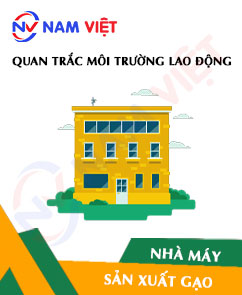
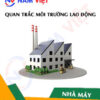
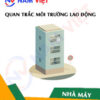





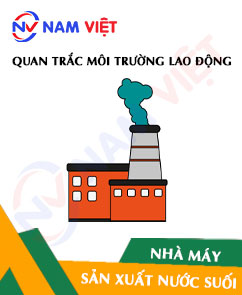

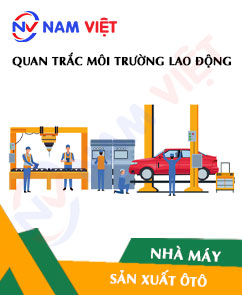
Review Occupational environment monitoring at the factory producing rice
There are no reviews yet.